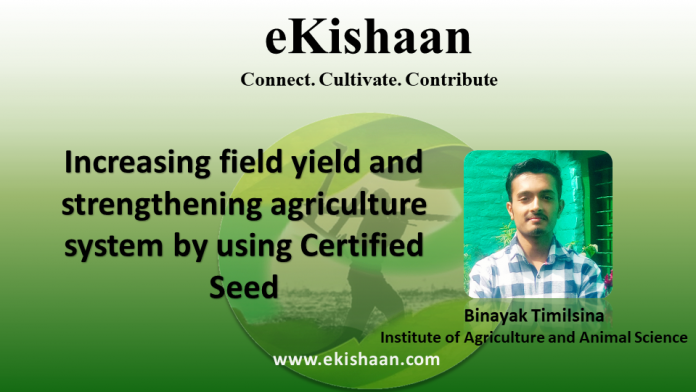Increasing field yield and strengthening agriculture system by using Certified Seed
Certified seed is the progeny of the foundation seed. Its production is so handled to maintain genetical identity and physical purity according to standards specified for the crop being certified. It should have the minimum genetical purity of 98-99%. Certified seed is produced from seed of known genetic origin and genetic purity, produced in a controlled and tested manner, processed and declared in accordance with the Law on Seeds. Seed quality is ensured through a lengthy production process that begins by establishing the seed crop varietal seeds, crop nurture and expert testing of crops, and ends after harvesting, processing, quality control and labelling. Production of certified seed is carried out under the supervision of the Ministry of Agriculture Development, via producers who are formally listed in the Seed Register. Processing of this seed is carried out at registered processing facilities, while quality testing is conducted at laboratories accredited for seed testing. Labels for packaging certified seed are issued by the organization authorized by the Ministry of Agriculture Development.
Only by sowing seed of certified genetic potential of varieties can we reach their full fruition, which is the goal of any agricultural producer. Advantages of using certified seed are as follows:
- Farmers who use certified seed receive higher quality seeds as a prerequisite for achieving higher yields (10-30%).
- The use of certified seed prevents the spread of weed species via seed, thereby reducing the number of treatments required with herbicides while reducing costs.
- Many diseases of cultivated plants are transferred via seed, which is why it is important to use seeds with the required health and specific purity.
Only seeds processed and treated at registered processing facilities are able to meet the prerequisites required for a healthy and bountiful crop. Seed processed at registered centers is at considerably higher level in terms of uniformity of seed size and seed quality than the seed saved by farmers from their own production. By treating seed at processing centers with fungicides and insecticides, in order to protect the seed from pests and diseases, a higher quality disbursement of particle preparations on the seed itself is ensured.
Damage resulting from the use of uncertified seed:
- Prolonged use of uncertified seed leads to a decline in fertility. Long time use of uncertified seed leads to the mixing of seeds of different varieties. A decline in fertility may also occur due to the crossing of different varieties of small grains.
- Uncertified seed is often infected with warehouse insects and diseases, given that they are most often kept in inadequate storage facilities.
- Uncertified seed has low germination rate and high impurities results in poor seed quality.
- Uncertified seed contains more weeds, broken seeds, empty shells, small and diseased seed than certified seed.
- The quality of uncertified seed is unknown because this seed is not tested at accredited laboratories. As a result, farmers sow at a rate determined in their head, which leads to sowing more or less seed than the recommended amount. They most often sow more seed than necessary. The effect of this practice is lodging crops, the emergence of disease, greater loss in harvests and lower yields, and therefore lower profits.
Conclusion
The use of certified seed should be encouraged; particularly self-pollinating plants, where the use of farm saved seed is most common. In order to achieve this goal, it is necessary to stimulate the use certified seed among farmers and educate them on all the advantages of using certified seed. Until awareness is raised among farmers on the use of certified seed, use of such seed will not increase. The damage caused by using uncertified seed would be reduced if regulations were passed allowing farmers to use seeds from their own production, though under the condition that production, harvest, storage and processing is carried out in a professional manner. It would be mandatory for such seed to be tested at an accredited laboratory. Due to low quality of uncertified seed, certified seed gives a higher yield than uncertified seed. Yield reductions most commonly total around 5%, but can be as high as 10-30%.
